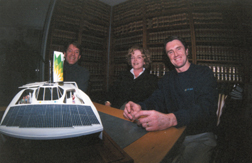 |
| Environmental activist
Russell Long, Executive Director of Bluewater Network,
Charlene Johnson, President of the San Francisco Bay Area
Water Transit Authority and Dr. Robert Dane (beaming). |
On our Cover
Here Comes the Sun
Bay Crossings sat down
with the inventor of the worldís first solar ferry to get
the story of how he went from country doctor to solar
entrepreneur. Here, in his own words, is his story.
By Dr. Robert Dane
Before all this started, I
was practicing as a country doctor about three hours south of
Sydney on the coast in a town called Ulladulla, which in
aboriginal means safe harbor. It boasts a very big fishing
industry and a very safe port. Itís the place where a lot of
the people sailing from Sydney to Hobart pull in if they get
in trouble.
I always wanted to be a country
doctor. I also loved sailing. I wanted to do obstetrics and
anesthetics in a country hospital setting so thatís what I
trained to do. After 10 years of school and training in the
hospitals in New South Wales I got into practice with this old
Scotsman. I learned a lot of things from him about life and
medicine and when he ceased operating I was the only doctor. It
was very stressful but very satisfying and rewarding, too.
While there, I bought a couple
of sailboards from the local Alludalla surfboard manufacturer,
Bruce Heggie. Bruce pioneered light fiberglass surfboard
technology. I love sailboarding and I love surfing. I met people
who are totally different than what I met doing medicine, people
who work with their hands.
The sea is in my blood. My
uncle was a sea captain, ran a boat down to King Island called the
King Islander. My great, great, great, great, great grandfather
was a guy called Captain Woodhouse who used to sail clipper ships
out to Australia.
All Iíve studied to do all my
life is medicine but I finished up loving the sea. So here I am in
this little country town, practicing medicine, great life, earning
lots of money. And then one day back in 1996, I happened to be
standing on the banks of the Burly Griffin, a man made lake. Every
year they have this solar boat race there.
Iím standing there with my
fair skin thinking, "Hereís the solar boat races. Thereís
all this energy in the sun. Iím a mad sailor. What about mixing
the two?" So Iím standing there watching these boffins (editorís
note: Australian for nerd), about forty entrants in
all. In my opinion they didnít understand boats but rather what
they were doing is applying solar car energy to boats, what I call
the tennis court theory of solar boats where you basically put a
flat area of solar panels and you sit underneath it. The problem
with just having a boat covered in solar panels is that you canít
angle your panels to the sun. I just knew that if you angled your
panels to the sun, youíd increase the amount of energy.
My family and I watched it all
for a couple hours. The band is playing and my kids are saying,
"Come on, Dad, letís go." Half way through the race
the wind picked up and people started taking the solar panels off
their boats because of the wind.
Iím not an engineer. I havenít
invented anything. But I did figure out that a solar sailing
vessel has to be able to sail in the sun and sail in the wind. I
knew it in my head and in my heart.
So with this in mind I
developed the criteria for a solar sailing vessel. It had to be
seaworthy. It had to use existing technology. It had to use the
wind and the sun. And then ó I went back to my medicine.
But all the while I kept
thinking. There are a whole lot of reasons why solar boats make
sense. Itís much easier to carry batteries on a boat. Plus thereís
more reflected light out on the water. In fact, the first day that
we took our solar sailor out on Sydney Harbor we blew every fuse
on the boat.
Then one morning I wake up at
four oíclock in the morning and bing!, the answer came to me:
solar wings, basically a wingsail that is pivotally mounted? I
remember thinking, "When the storms come, you can fold the
wings down onto the roof of the boat like a beetle. Then the wind
could go over the top and it would still collect solar
energy."
I found in my bookshelf of
medical books a book on evolution. The fundamental difference
between the creationists and the evolutionists is that the
creationists maintain that God made all the animals. Period.
Evolutionists say they evolved. The creationistís argument
against evolution focuses on the eye, no pun intended. They ask,
what good is half an eye? What good is an eye before you can use
it see?
The answer is that you can
track the sun. The other argument that creationists put forward is
what good is half a wing? How do you evolve a wing? The
evolutionists come along and say it was used for something else
before it was used to fly. For example, larger animals used wings
for gliding. They crawled up to the top of a tree where they could
glide off. This evolved into flying.
The moment that changed my life
was when I was reading on an airplane on my way to a vacation on
Whit Sundays, a cruising area for yachts. My book was explaining
that ninety percent of the species on this earth are insects and,
further, that ninety percent of insects fly. I was fascinated to
learn that insects initially evolved wings as solar collectors and
only thereafter used them to fly.
CONTINUE